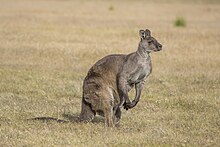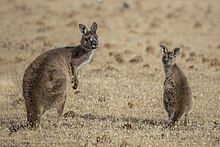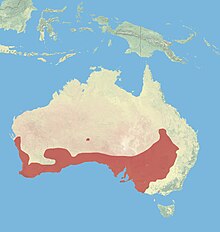
Kangaroos are marsupials from the family Macropodidae. In common use the term is used to describe the largest species from this family, the red kangaroo, as well as the antilopine kangaroo, eastern grey kangaroo, and western grey kangaroo. Kangaroos are indigenous to Australia and New Guinea. The Australian government estimates that 42.8 million kangaroos lived within the commercial harvest areas of Australia in 2019, down from 53.2 million in 2013.
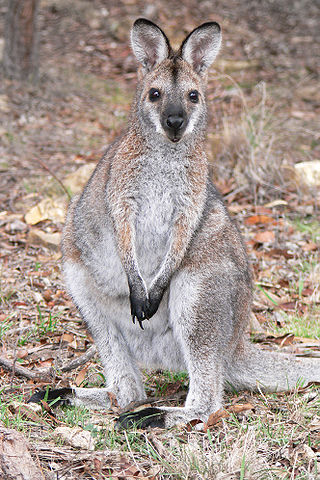
Macropodidae is a family of marsupials that includes kangaroos, wallabies, tree-kangaroos, wallaroos, pademelons, quokkas, and several other groups. These genera are allied to the suborder Macropodiformes, containing other macropods, and are native to the Australian continent, New Guinea and nearby islands.

The eastern grey kangaroo is a marsupial found in the eastern third of Australia, with a population of several million. It is also known as the great grey kangaroo and the forester kangaroo. Although a big eastern grey male can typically weigh up to 66 kg (146 lb) and have a length of well over 2 m, the scientific name, Macropus giganteus, is misleading: the red kangaroo of the semi-arid inland is larger, weighing up to 90 kg (200 lb).
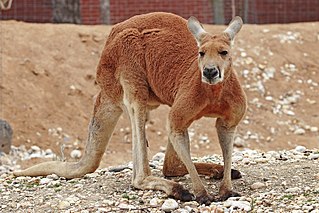
The red kangaroo is the largest of all kangaroos, the largest terrestrial mammal native to Australia, and the largest extant marsupial. It is found across mainland Australia, except for the more fertile areas, such as southern Western Australia, the eastern and southeastern coasts, and the rainforests along the northern coast.

The red-necked wallaby or Bennett's wallaby is a medium-sized macropod marsupial (wallaby), common in the more temperate and fertile parts of eastern Australia, including Tasmania. Red-necked wallabies have been introduced to several other countries, including New Zealand, the United Kingdom, Ireland, the Isle of Man, France and Germany.

The tammar wallaby, also known as the dama wallaby or darma wallaby, is a small macropod native to South and Western Australia. Though its geographical range has been severely reduced since European colonisation, the tammar wallaby remains common within its reduced range and is listed as "Least Concern" by the International Union for Conservation of Nature (IUCN). It has been introduced to New Zealand and reintroduced to some areas of Australia where it had been previously extirpated. Skull variations differentiate between tammar wallabies from Western Australia, Kangaroo Island, and mainland South Australia, making them distinct population groups.

The term Australian megafauna refers to the megafauna in Australia during the Pleistocene Epoch. Most of these species became extinct during the latter half of the Pleistocene, and the roles of human and climatic factors in their extinction are contested.

The Tasmanian pygmy possum, also known as the little pygmy possum or tiny pygmy possum, is the world's smallest possum. It was first described by Oldfield Thomas in 1888, after he identified that a museum specimen labelled as an eastern pygmy possum in fact represented a species then unknown to science. The holotype resides in the Natural History Museum in London.

The swamp wallaby is a small macropod marsupial of eastern Australia. This wallaby is also commonly known as the black wallaby, with other names including black-tailed wallaby, fern wallaby, black pademelon, stinker, and black stinker on account of its characteristic swampy odour.

Kangaroo meat is produced in Australia from wild kangaroos and is exported to over 61 overseas markets.

Macropus is a marsupial genus in the family Macropodidae. It has two extant species of large terrestrial kangaroos. The term is derived from the Ancient Greek μάκρος, makros "long" and πους, pous "foot". Thirteen known extinct species are recognised. The type species is the eastern grey kangaroo.
Grey kangaroo is a kangaroo that is grey. Species include:
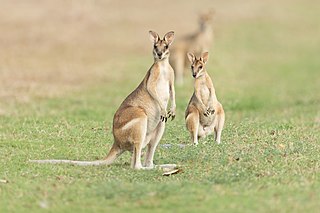
The agile wallaby, also known as the sandy wallaby, is a species of wallaby found in northern Australia and southern New Guinea. It is the most common wallaby in north Australia. The agile wallaby is a sandy colour, becoming paler below. It is sometimes solitary and at other times sociable and grazes on grasses and other plants. The agile wallaby is not considered threatened.

The whiptail wallaby, also known as the pretty-faced wallaby, is a species of wallaby found in eastern Australia. It is locally common from Cooktown in Queensland to near Grafton in New South Wales.

The western brush wallaby, also known as the black-gloved wallaby, is a species of wallaby found in the southwestern coastal region of Western Australia. The wallaby's main threat is predation by the introduced red fox. The IUCN lists the western brush wallaby as Least Concern, as it remains fairly widespread and the population is believed to be stable or increasing, as a result of red fox control programs.

The antilopine kangaroo, also known as the antilopine wallaroo or the antilopine wallaby, is a species of macropod found in northern Australia: in Cape York Peninsula in Queensland, the Top End of the Northern Territory, and the Kimberley region of Western Australia. It is a locally common, gregarious grazer.

The black wallaroo, also known as Woodward's wallaroo, is a species of macropod restricted to a small, mountainous area in Arnhem Land, Northern Territory, Australia, between South Alligator River and Nabarlek. It classified as near threatened, mostly due to its limited distribution. A large proportion of the range is protected by Kakadu National Park.

The common wallaroo, also known as the euro, hill wallaroo, or simply wallaroo, is a species of macropod. The word euro is particularly applied to one subspecies.

Macropod hybrids are hybrids of animals within the family Macropodidae, which includes kangaroos and wallabies. Several macropod hybrids have been experimentally bred, including:
Macropus pan is a species of marsupial that existed during the Pliocene in Australia, known only from fossils located at several sites across Australia. The species is recognised as allied to the modern grey kangaroos, the western Macropus fuliginosus and eastern Macropus giganteus, in a clade initially named as subgenus Macropus (Macropus) Dawson & Flannery. The first description was provided by Charles W. De Vis in 1895, emerging from the author's examination of fossil material held at the Queensland Museum. Fossil specimens of Quanbun local fauna, named for a site in Western Australia, were also identified as this species. The origin of the type specimen was not recorded, although based on comparisons to material with a known provenance it is assumed to have excavated at Chinchilla, Queensland. A larger macropod than any modern species, the standing height was estimated to be over two metres.
